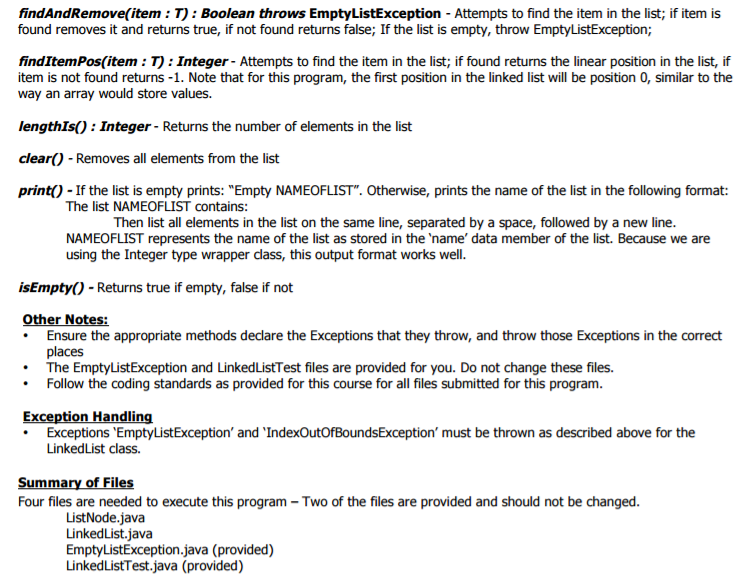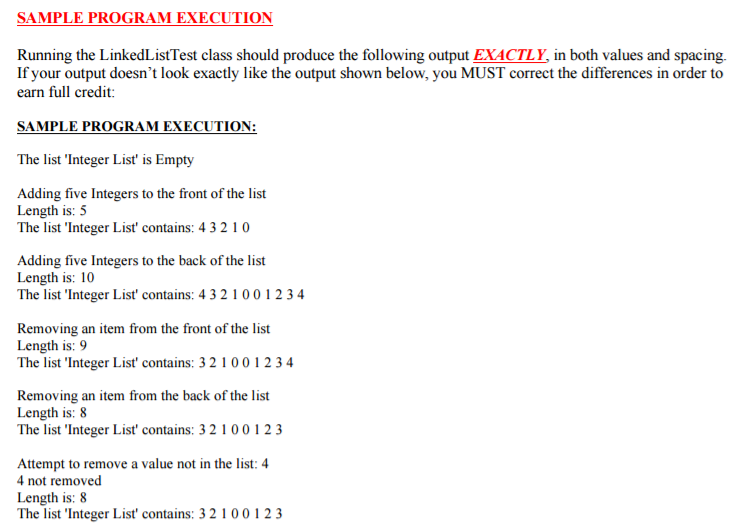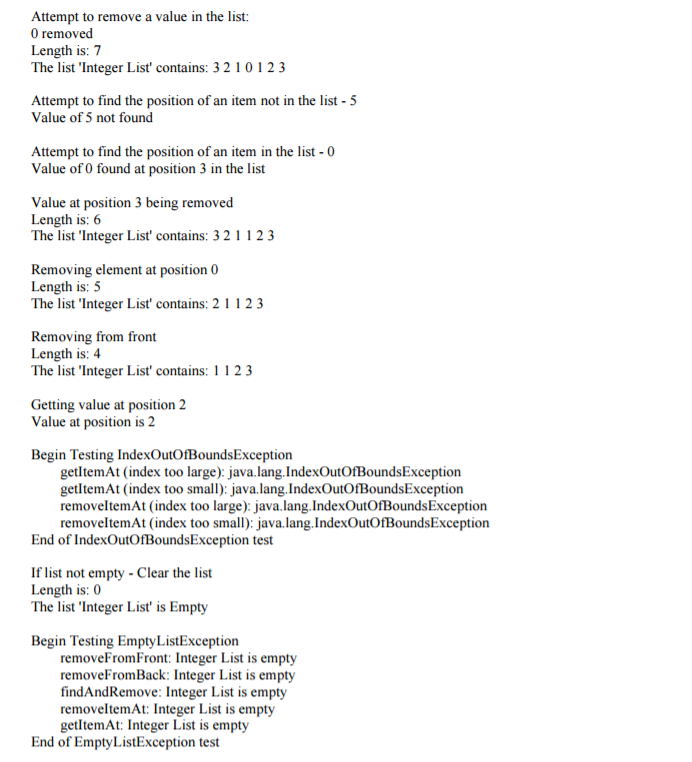Question
Defining a linkedlist of dynamically allocated nodes with mutilple java files. Help creating ListNode java code and the LinkedList code for this java program. The
Defining a linkedlist of dynamically allocated nodes with mutilple java files. Help creating ListNode java code and the LinkedList code for this java program. The other two files are provided and the code listed at the bottom.




 \
\
Code for EmptyListException.java:
// Filename: EmptyListException.java // Defines the Exception - EmptyListException that can be thrown // when an operation is requested that is not supported for an empty list // // This class will be stored in the ExceptionPkg package.
package ExceptionPkg; public class EmptyListException extends RuntimeException { // constructor with no parameter public EmptyListException () { this ("List"); } // constructor with .String. parameter public EmptyListException (String name) { // call super class constructor super (name + " is empty"); } }
------------------------------------------------------------
Code for LinkedListTest.java:
// Filename: LinkedListTest.java
// // This file contains a main method to create an object of type LinkedList and // test all the methods defined for the LinkedList class.
// Import the LinkedList and EmptyListException classes from their appropriate packages import ListPkg.LinkedList; import ExceptionPkg.EmptyListException;
import java.util.Scanner;
public class LinkedListTest { public static void main(String[] args) {
// Create the linked list object 'myList' to hold Integer objects and print the list LinkedList
System.out.println(); myList.print(); System.out.println();
// Add five items to the front of the list and print the list System.out.println("Adding five Integers to the front of the list"); for(int x = 0; x
// Add five items to the back of the list and print the list System.out.println("Adding five Integers to the back of the list"); for(int x = 0; x
// remove an item from the front and from the back of the list // print the list System.out.println("Removing an item from the front of the list"); try { myList.removeFromFront(); } catch(EmptyListException ELE) { System.out.print(ELE.getMessage()); } printLengthAndList(myList); System.out.println("Removing an item from the back of the list"); try { myList.removeFromBack(); } catch(EmptyListException ELE) { System.out.print(ELE.getMessage()); } printLengthAndList(myList);
// Try to remove the Integer value 4 from the list // catch the EmptyListException if thrown // display the list System.out.println ("Attempt to remove a value not in the list: 4"); try { if(myList.findAndRemove(4)) { System.out.println("4 removed"); } else { System.out.println("4 not removed"); } } catch(EmptyListException ELE) { System.out.println(ELE.getMessage()); } printLengthAndList(myList);
// Try to remove the Integer value 0 from the list // catch the EmptyListException if thrown // display the list System.out.println ("Attempt to remove a value in the list: "); try { if(myList.findAndRemove(0)) { System.out.println("0 removed"); } else { System.out.println("0 not removed"); } } catch(EmptyListException ELE) { System.out.println(ELE.getMessage()); } printLengthAndList(myList);
// Try to find position of an item not in the list System.out.println("Attempt to find the position of an item not in the list - 5"); int position = myList.findItemPos(5); if(position!=-1) { System.out.printf("Value of 5 found at %d ", position); } else { System.out.println("Value of 5 not found"); }
// Try to find position of an item in the list System.out.println(" Attempt to find the position of an item in the list - 0"); position = myList.findItemPos(0); if(position!=-1) { System.out.printf("Value of 0 found at position %d in the list ", position); } else { System.out.println("Value of 0 not found"); } // Remove the item at 'position' in the list System.out.printf(" Value at position %d being removed ", position); myList.removeItemAt(position); printLengthAndList(myList);
// Remove the first element in the list - item at position 0 System.out.println("Removing element at position 0"); myList.removeItemAt(0); printLengthAndList(myList);
// Remove the first element in the list - item at the front System.out.println("Removing from front"); myList.removeFromFront(); printLengthAndList(myList);
// get the object at position 2 in the list System.out.println("Getting value at position 2"); Integer temp = myList.getItemAt (2); System.out.printf("Value at position is %d ", temp);
// Test the 'getItemAt' method for the IndexOutOfBoundsException System.out.println(" Begin Testing IndexOutOfBoundsException"); try { myList.getItemAt(4); } catch(IndexOutOfBoundsException IOBE) { System.out.println("\tgetItemAt (index too large): " + IOBE); } try { myList.getItemAt(-1); } catch(IndexOutOfBoundsException IOBE) { System.out.println("\tgetItemAt (index too small): " + IOBE); }
// Test the 'remove' method for the IndexOutOfBoundsException try { myList.removeItemAt(4); } catch(IndexOutOfBoundsException IOBE) { System.out.println("\tremoveItemAt (index too large): " + IOBE); }
try { myList.removeItemAt(-1); } catch(IndexOutOfBoundsException IOBE) { System.out.println("\tremoveItemAt (index too small): " + IOBE); }
System.out.println("End of IndexOutOfBoundsException test ");
// Clear list System.out.println("If list not empty - Clear the list"); if(!myList.isEmpty()) { myList.clear(); } printLengthAndList(myList);
System.out.println(" Begin Testing EmptyListException");
// test removeFromFront, removeFromBack, findAndRemove, removeItemAt and getItemAt with // the empty list try { myList.removeFromFront(); } catch(EmptyListException ELE) { System.out.println("\tremoveFromFront: " + ELE.getMessage()); }
try { myList.removeFromBack(); } catch(EmptyListException ELE) { System.out.println("\tremoveFromBack: " + ELE.getMessage()); }
try { myList.findAndRemove(0); } catch(EmptyListException ELE) { System.out.println("\tfindAndRemove: " + ELE.getMessage()); }
try { myList.removeItemAt(0); } catch(EmptyListException ELE) { System.out.println("\tremoveItemAt: " + ELE.getMessage()); }
try { myList.getItemAt(0); } catch(EmptyListException ELE) { System.out.println("\tgetItemAt: " + ELE.getMessage()); }
System.out.println("End of EmptyListException test "); }
// Method: printLengthAndList (LinkedList
Step by Step Solution
There are 3 Steps involved in it
Step: 1

Get Instant Access to Expert-Tailored Solutions
See step-by-step solutions with expert insights and AI powered tools for academic success
Step: 2

Step: 3

Ace Your Homework with AI
Get the answers you need in no time with our AI-driven, step-by-step assistance
Get Started


